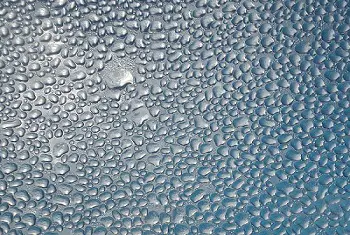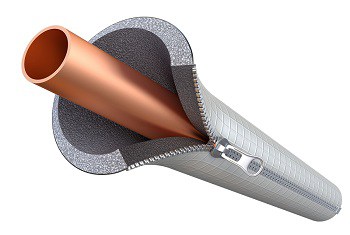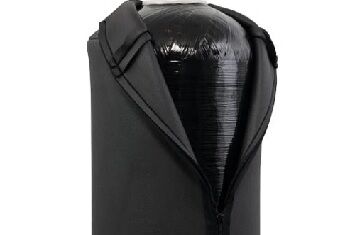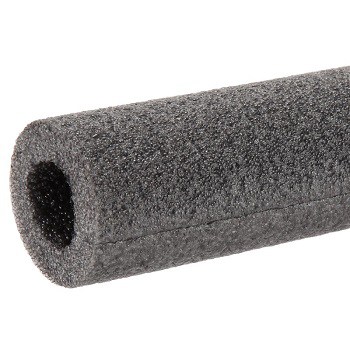UPDATED: March 12, 2022
Finding some condensation (sweating) on the outside of your water softener or any type of water treatment system is not at all uncommon. Whenever there is cold water running through a pipe or tank and there are warm air and humidity on the outside, there can be condensation.
Sweating on pipes or a water softener occurs when the water running through the pipe or system is considerably colder than the air on the outside. When the warmer outside air comes in contact with the cold pipe or system, humidity from the warm air collects on the colder surface as condensation or sweat.
Sweating on the outside of a water softener is common and in many cases, there is no need to remedy the problem. But sometimes, excessive sweating on a water softener can be a problem. Fortunately, you can do something about it once you know a little about what causes it.
How does sweat form on a water softener anyway?
Sweating on a water softener is just like sweating on the outside of a glass of iced tea on a warm humid day. The iced tea is very cold on the inside causing water droplets to form from the warm humid air on the outside.
Having sweating pipes or a water softener that sweats is very common if you live in a warm and humid climate.
The Southern United States or the midwest united states are perfect examples of areas where the humidity and temperature are very high, making these areas ideal places for water softener sweating to occur.
Sweat (condensation) forms either when the amount of water vapor in the air becomes too dense to stay suspended in the air and falls out onto a surface that it comes into contact with or when water vapor in the air is cooled to reach its dew point.

The dew point is when water vapor in the air reaches a temperature that causes the water vapor to condense and form water droplets that collect on surfaces that it comes into contact with that are cooler than the surrounding air.
Water that forms on cool pipes and water tanks is actually dew, which is water suspended in the atmosphere.
If the water inside of a pipe warms to the temperature of the surrounding air, condensation will not occur.
We see condensation all the time and all around us. The clouds in the sky are made up of small droplets of water that have collected in a mass of air.
When this mass comes into contact with a cool front of air, the droplets merge together and become too heavy to stay in suspension, and therefore they fall down to the earth as rain.
Side Fact: When raindrops form in clouds, they are actually forming around tiny particles in the air. These tiny particles are called Cloud Condensation Nuclei or (CCN). These particles are often particles of clay, salt, or common air-bound pollution like smoke from wildfires.
Is Your Water Softener Draining Continously?
Condensation is most likely to appear on your water softener when water is running through it.
A leaking seal or a seized piston inside of your water softener can allow water to continuously flow through the water softener which will keep the water cold inside of the water softener tank which can lead to condensation developing on the outside of the water softener tank.
Make Sure That Your Water Softener Is Not Regenerating Too Often!
If your water softener hardness setting is set higher than it needs to be, your water softener will regenerate more often than it needs to which leads to more sweating on your water softener.
A water softener that regenerates once per week may sweat, but the sweat (condensation) may evaporate in between regenerations and therefore not be a problem.
But If your water softener is set to regenerate every day, the condensation will not have a chance to evaporate in between regenerations and can continue to develop to the point where it can create enough condensation for the condensation to end up creating a puddle of water on your floor.
Is Sweating On A Water Softener A Problem?
As far as the operation of the water softener is concerned, sweating is actually a sign that it is working just fine and your water is running through it.
Depending on the temperature of your water coming into the house and the temperature and humidity in the location of your water softening system, you might only notice sweating on the pipes and tank every few days.
This is most likely because your water softener is sweating considerably more when it is in its regeneration process. During its regeneration process, a large volume of cold water is running through the system and therefore dramatically cooling the outsides of the tank and surrounding pipes.
When this happens, any humidity that is in the air can quickly turn into condensation on the outside of the tank and pipes. Sometimes this condensation can be excessive and leave a significant amount of water on the floor, but it is usually not enough to where many people find it to be a concern.
If you were to find your pipes sweating but not your water softener tank, then your water may not be going through your water softener and your water going to the house is not soft.
This would apply to any of your water treatment systems, including acid neutralization systems or backwashing filters.
Although sweating on a pipe or water tank may greatly increase during a water softeners regeneration process due to the extra amount of water used, if you notice several gallons of water on the floor by your water softener even when the temperature is not hot and the humidity is low, you should consider calling a professional to check the system for leaks.
What to do about a sweating water softener?
The best solutions to a sweating water softener are to eliminate the source of the water (the humidity in the air) or to create a barrier between the extreme cold of the tank and the warm and humid outside air.
Ideally, a dehumidifier like one of the ones that I highly recommend (See Recommended De-humidifiers) is a great solution to this problem.
Removing excessive humidity from the air will leave less chance for condensation to accumulate. But even a de-humidifier may not be enough if the temperature is very hot and the humidity is high.
Also, a dehumidifier requires emptying of the reservoir often which can be a bother, but usually, a dehumidifier will have the ability to run a drain hose from the humidifier to a floor drain or an external drain.
Sometimes just getting the situation under control is better than trying to alleviate the problem altogether.
Does wrapping water pipes help stop condensation?
By wrapping the tank and pipes with an insulating cover, we can create a kind of neutral zone between the ice-cold water inside of the tank and the heat outside the tank.

By not enabling the warm humid air to directly make contact with the ice-cold tank, considerably less condensation will be able to come out of the humid air.
This zone that is neither very cold nor very hot and humid creates a more neutral climate and can greatly reduce how much your water softener will sweat. I recommend using neoprene tank wraps to create a breathable barrier around the tank.

This will help to decrease the amount of sweat on the tank. I have seen people use ordinary bubble wrap to create a similar barrier effect, but I have found that in very humid conditions, a neoprene tank jacket works much better.
Foam pipe wrapping on water pipes will help to insulate them from the surrounding warm and humid air.

Be sure to use the correct size for your pipes, gaps in the insulation or insulation that is too loose will provide enough surface area for sweat to form and bacteria to grow.
Putting a drip tray underneath the tank that will catch the condensation works well as long as you do not let it overflow and put a little chlorine bleach in it every so often to prevent the growth of any bacteria or mold.
Are you having trouble getting your sweating problem under control?
Get more detailed information from my article: How Can I Stop Condensation On My Water Softener?


Great article, very informative. my question: I have a system with three 10 X54 tanks and a salt bin. the tanks sweat a lot even after installing neoprene jackets. I get puddles on the floor! Would it help if I wrap more neoprene over the jackets? the installer is not responsive to my calls. the plumbing does not leak and the system is in the garage with no climate control. a fan on high speed helps but I worry about the cost of electricity. Any advice will be appreciated.
Hello Kindt, and thank you for the comment.
Since this is such a great question, and I feel that it requires more than just a simple answer, I decided to write a whole new article about it. Please check out How Can I Stop Condensation On My Water Softener?. And thanks again for the great question.